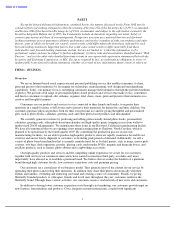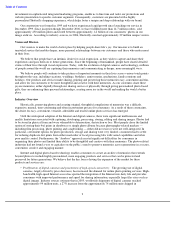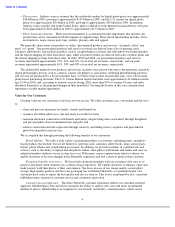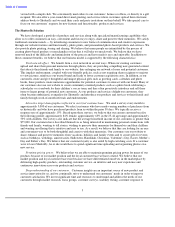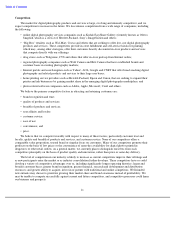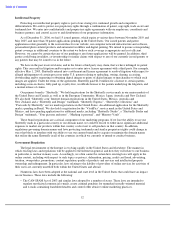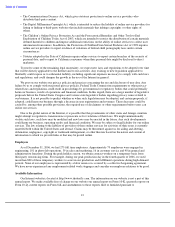Shutterfly 2007 Annual Report Download - page 8
Download and view the complete annual report
Please find page 8 of the 2007 Shutterfly annual report below. You can navigate through the pages in the report by either clicking on the pages listed below, or by using the keyword search tool below to find specific information within the annual report.
Table of Contents
Addressable Markets
Digital cameras, digital image processing and the Internet have dramatically changed the photo-related services
market, and have created entirely new ways for consumers to capture, edit, enhance, organize, find, share, create,
print and preserve images. In particular, the range and quality of printed photos, photo-based products, photo-based
merchandise and ancillary products have expanded and improved significantly, while associated production costs and
the time required to create this output have decreased dramatically. Consequently, companies like Shutterfly are now
addressing a wide variety of consumer needs and multiple, large markets in ways not possible with earlier
technology.
We currently address several adjacent markets related to consumers’ desire to be thoughtful and creative with
their memories. These include, but are not limited to:
3
2004. Industry sources estimate that by the end of 2006, there will be more than 1 billion Internet users
worldwide. In the U.S., industry sources estimate that approximately 58 million households have both Internet
connectivity and a digital camera.
•
Increasing convenience and quality of online photo services.
Online photo services provide multiple
advantages over at-home or retail printing. Although at-home photo printing is instantaneous, it requires an
investment in a printer, photo paper and ink, resulting in a much higher cost per print and is time consuming.
In addition, the quality rendered is usually inferior compared to commercially produced prints. Retail printing,
while offering higher quality than at-home printing, requires the consumer to make a trip to the retail
establishment to pick up his or her prints. Both at-home and retail printing can produce prints of inconsistent
quality, have a limited variety of photo-based products and few or no personalization options, and require the
consumer to handle shipping or delivery of the product to the final recipient, often with additional costs in
time and money.
In contrast, online photo services conveniently provide a wide variety of customized, high-quality photo-
based products delivered directly to consumers
’
doorsteps.
• Growing consumer desire to find easy, hassle-free ways to generate personalized content. Consumers are
interested in creating highly customized and personalized photo-based products and merchandise to preserve
their precious memories, express their creativity and make gift giving more personal and thoughtful.
Improvements in software and photo editing tools have enabled consumers to modify their photos quickly and
easily using a personal computer. Consumers are now able to create digital compilations of memories that
were previously only possible through a physical and more time
-
consuming process.
•
Participation in online communities.
Consumers have become increasingly comfortable with using the
Internet as a forum for sharing and publishing information in open or permission-
based networks. Many of the
most popular online communities include user-generated, rich-media content such as photos and videos
because of visual content
’
s inherent ability to communicate more powerfully than the written word.
• Greeting cards and stationery. According to the Greeting Card Association’s website, U.S. consumers
purchase approximately 7 billion greeting cards each year, generating nearly $7.5 billion in retail sales. More
than 90 percent of all U.S. households buy greeting cards, with the average household purchasing
30 individual cards per year. The Greeting Card Association also reports that nine out of ten Americans say
they look forward to receiving personal letters and greeting cards because cards allow them to keep in touch
with friends and family and make them feel they are important to someone else.
• Scrapbooks. According to a 2004 survey by Creating Keepsakes and Craftrends magazine, the
U.S. scrapbook industry was approximately $2.55 billion in 2004, up 27.8% from 2001. Additionally,
approximately 61% of scrapbookers have at least a college degree and spend almost three hours a week
assembling their memories into scrapbooks.
• Calendars. A 2002 guide published by the Calendar Marketing Association estimated that 500 million
calendars are produced annually in the United States and that approximately 98% of American households
have at least one calendar.






